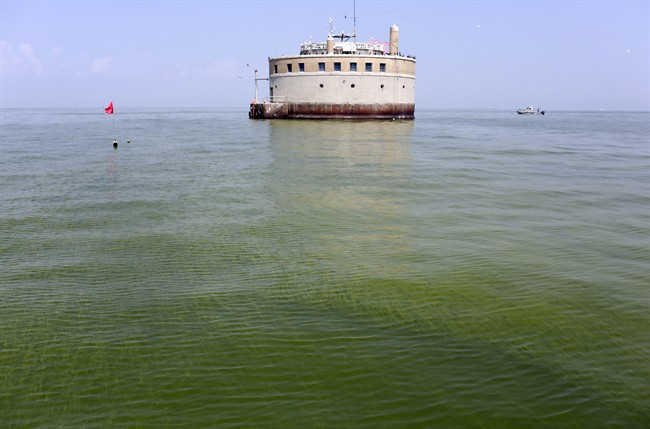TOLEDO, Ohio – Toledo has detected the first signs in Lake Erie of the dangerous toxin that resulted in a water crisis last year that left 400,000 people in northwestern Ohio and southeastern Michigan without safe tap water for two days.

Toledo Mayor Paula Hicks-Hudson and city officials announced late Monday that the intake mechanisms that draw Toledo’s drinking water from Lake Erie detected a toxin that can cause liver and kidney damage, The Blade reported.
READ MORE: It came from Lake Erie: Why toxic algae’s a nightmare for Canada, too
The mayor says the city’s drinking water remains safe but she has updated the status of the water to a “Watch” category. The next stage, “Caution,” means a toxin has been detected in tap water but the level isn’t great enough to require an advisory.
A severe toxic algae outbreak on the lake’s western end – where the toxin was recently detected – was forecast after heavy rains in June washed huge amounts of algae-feeding phosphorus into the lake.
Hicks-Hudson emphasized that the toxin, microcystin, was detected about 3 miles out in the lake and has not been detected inside the Collins Park Water Treatment Plant, which treats the water for hundreds of thousands of residents in the area.
“A very small amount of microcystin was detected in the intake crib … and that is 0.5 parts per billion and below in the raw lake water,” the mayor said. “(That) is equal to about one-half a blade of grass in a football field.”
Two common toxins, including microcystin, come from blue-green algae and can cause rashes, hives, skin blisters, vomiting and diarrhea and have killed dogs and livestock. Long-term exposure can damage the liver and kidneys.
Milt Miller, the lake’s restoration manager, emphasized Tuesday that microcystin levels are down from last year and the lake isn’t nearly as green as it typically is this time of year, when the water warms and algae can grow.
Other than swimming, the lake is open for business and is full of boaters, anglers and water skiers, Miller said.
Treatment protocols in place also are removing the toxin before it reaches the homes of about 500,000 people in the Toledo area that uses the municipal water supply.
Chuck Campbell, Toledo’s commissioner of water treatment, said new monitoring devices have helped detections occur much earlier today than it could have during the crisis last August.
The U.S. Environmental Protection Agency said in May it is fine for people school-age and older to drink tap water containing up to 1.6 parts per billion of microcystin. The World Health Organization follows stricter guidelines, as does Ohio. The Ohio Environmental Protection Agency ordered the city of Toledo to declare the crisis last summer once the toxin level in tap water went above 1.0 ppb.
On Tuesday, the state also recommended that people and pets avoid swimming and wading in Grand Lake St. Marys, Ohio’s largest inland lake, as levels of the algae-produced toxin rises. Public health officials are also encouraging boaters and jet skiers to understand the risk of exposure to higher levels of microcystin.
Similar signs went up last year at Grand Lake St. Marys, a 20-square-mile lake between Dayton and Toledo.
Efforts to clean up the lake date back several years. A toxic algae bloom in 2010 hurt the region’s tourism and highlighted problems from farm phosphorous runoff.



Comments